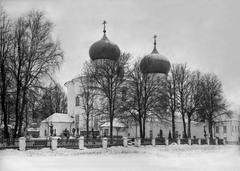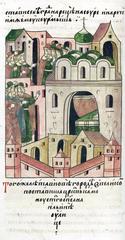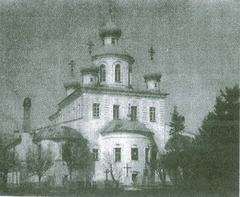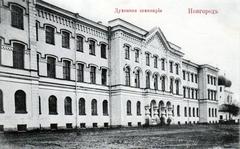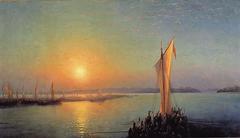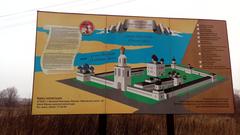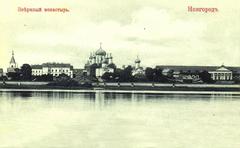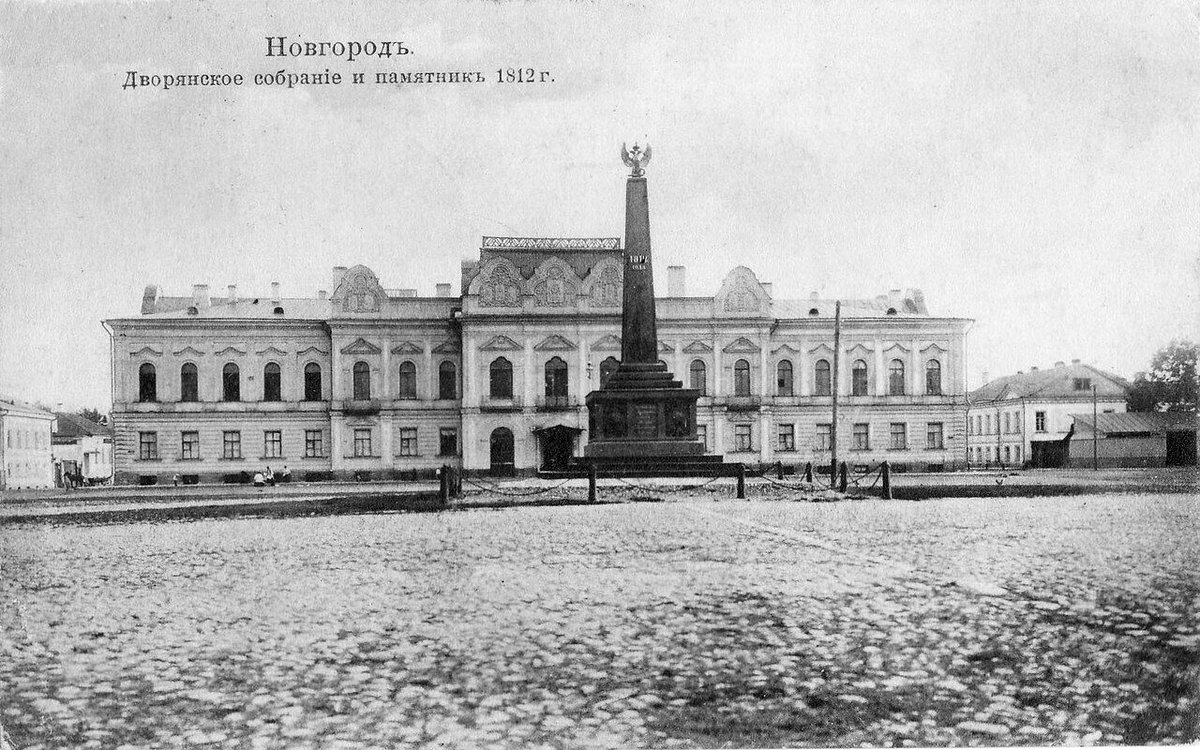
Visiting Hours and Tickets for Музей изобразительных искусств
Publication Date: 31/07/2024
Introduction
Discover the rich cultural heritage of Veliky Novgorod by visiting the Музей изобразительных искусств (Museum of Fine Arts). This comprehensive guide provides essential information for a fulfilling visit. Whether you’re an art enthusiast, a history buff, or simply looking to explore the cultural treasures of Veliky Novgorod, this guide will walk you through the museum’s fascinating history, significant collections, practical visitor information, and more. The Museum of Fine Arts is housed in a historical building that originally served as the Noble Assembly, constructed in 1851 by architect Andrei Ivanovich Stackenschneider. Over the years, this iconic structure has been the venue for many significant events, including the 1862 celebrations marking the Millennium of Russian Statehood, attended by Emperor Alexander II and his family (Novgorod Museum). Today, the museum boasts an extensive collection of Russian and European art from the 18th to the early 20th centuries, featuring works by renowned artists such as Dmitry Levitsky, Karl Bryullov, and Ilya Repin, among others (Visit Novgorod).
Table of Contents
- Introduction
- History of the Музей изобразительных искусств, Veliky Novgorod
- Exhibitions and Collections
- Restoration and Preservation Efforts
- Visitor Information and Tips
- Educational and Cultural Programs
- Accessibility and Visitor Services
- Nearby Attractions and Travel Tips
- Future Plans and Developments
- Frequently Asked Questions (FAQ)
- Conclusion
History of the Музей изобразительных искусств, Veliky Novgorod
Origins and Architectural Significance
The Музей изобразительных искусств in Veliky Novgorod is housed in the former building of the Noble Assembly, constructed in 1851 by architect Andrei Ivanovich Stackenschneider. Initially designed as the main administrative and public edifice of Novgorod, the building reflects the architectural grandeur of the mid-19th century. The original facade featured pediments in the form of kokoshniks with sculpted coats of arms of the district towns of the Novgorod province. However, significant alterations were made in the 1950s, including the addition of a third floor and the construction of a portico supported by eight massive columns (Novgorod Museum).
Historical Events and Uses
The building has hosted numerous significant events throughout its history. In 1862, it was the venue for the celebrations marking the Millennium of Russian Statehood, attended by Emperor Alexander II and his family. Another notable event was the XV All-Russian Archaeological Congress held in 1911. During the Soviet era, the building served various organizations and educational institutions, reflecting its versatile use over time (Visit Novgorod).
Transformation into a Museum
In 2001, the building was repurposed to house the Museum of Fine Arts, showcasing an extensive collection of Russian and European art from the 18th to the early 20th centuries. This transformation marked a new chapter in the building’s history, aligning with its cultural and historical significance. The museum’s collection includes works by renowned artists such as Dmitry Levitsky, Karl Bryullov, Vasily Tropinin, Ivan Aivazovsky, Ilya Repin, Isaac Levitan, Valentin Serov, Nicholas Roerich, and Kuzma Petrov-Vodkin (Novgorod Museum).
Exhibitions and Collections
Permanent Collections
The museum’s permanent exhibition, “Russian Art of the 18th-20th Centuries,” offers a comprehensive overview of the development of Russian art during this period. The collection is notable for its diversity, encompassing various genres and styles. Highlights include Mikhail Nesterov’s “Annunciation” and Viktor Vasnetsov’s “Guslars,” as well as a sculpture by Mikhail Vrubel titled “Volkhov,” crafted in the majolica technique (Visit Novgorod).
Notable Exhibitions and Events
The museum frequently hosts temporary exhibitions and events that highlight various aspects of Russian and European art. Recent exhibitions have included “Novgorod in the Works of E.K. Evenbach (1889-1981),” “Novgorod Liberated: Paintings and Graphics by A.K. Krylov,” and “Reading Pushkin.” These exhibitions provide visitors with a deeper understanding of the cultural and historical context of the artworks on display (Novgorod Museum).
Restoration and Preservation Efforts
The museum has been actively involved in restoring and preserving its collections and the building itself. Regular exhibitions of graphic works and other art forms are held, contributing to the cultural enrichment of Veliky Novgorod. The museum also participates in various cultural and educational initiatives, including public lectures, concerts, and theatrical performances (Novgorod Museum).
Visitor Information and Tips
The Museum of Fine Arts is open daily from 10:00 to 18:00, with extended hours on Thursdays from 13:00 to 21:00. It is closed on Mondays and the last Wednesday of each month for sanitation. Visitors can book guided tours by contacting the museum’s information center or via email (Visit Novgorod).
Educational and Cultural Programs
The museum offers a range of educational and cultural programs designed to engage visitors of all ages. These programs include art workshops, lectures, and interactive tours that explore the rich artistic heritage of Veliky Novgorod. The museum also collaborates with local schools and universities to promote art education and appreciation among students (Visit Novgorod).
Accessibility and Visitor Services
The museum is committed to providing an accessible and welcoming environment for all visitors. It offers various services, including audio guides, wheelchair access, and special tours for visitors with disabilities. The museum’s staff is trained to assist visitors and ensure a pleasant and informative experience (Novgorod Museum).
Nearby Attractions and Travel Tips
While visiting the Museum of Fine Arts, take the opportunity to explore other nearby attractions such as the Novgorod Kremlin, St. Sophia Cathedral, and the Yaroslav Courtyard. These sites offer a deeper insight into the rich history and culture of Veliky Novgorod. For a more enjoyable visit, consider staying at a nearby hotel and trying local cuisine at one of the city’s many restaurants.
Future Plans and Developments
Looking ahead, the Museum of Fine Arts plans to expand its collection and enhance its exhibition spaces. Upcoming projects include the renovation of existing galleries and the creation of new interactive exhibits that utilize modern technology to engage visitors. The museum also aims to strengthen its partnerships with other cultural institutions and continue its role as a leading center for art and culture in Veliky Novgorod (Visit Novgorod).
Frequently Asked Questions (FAQ)
Q: What are the opening hours of the Museum of Fine Arts?
A: The museum is open daily from 10:00 to 18:00, with extended hours on Thursdays from 13:00 to 21:00. It is closed on Mondays and the last Wednesday of each month for sanitation.
Q: How much are the tickets?
A: Ticket prices vary depending on the exhibition. For the latest information, please visit the museum’s official website or contact the information center.
Q: Is the museum accessible?
A: Yes, the museum offers wheelchair access, audio guides, and special tours for visitors with disabilities.
Q: Can I book a guided tour?
A: Yes, guided tours can be booked by contacting the museum’s information center or via email.
Conclusion
References
- Visit the Museum of Fine Arts in Veliky Novgorod: History, Tickets, and Visitor Information, 2024, Novgorod Museum (Novgorod Museum)
- Ultimate Visitor Guide to Музей изобразительных искусств in Veliky Novgorod: Hours, Tickets, and Tips, 2024, Visit Novgorod (Visit Novgorod)
- Visiting Музей изобразительных искусств in Veliky Novgorod: Hours, Tickets, and Must-See Exhibitions, 2024, Visit Novgorod (Visit Novgorod)

